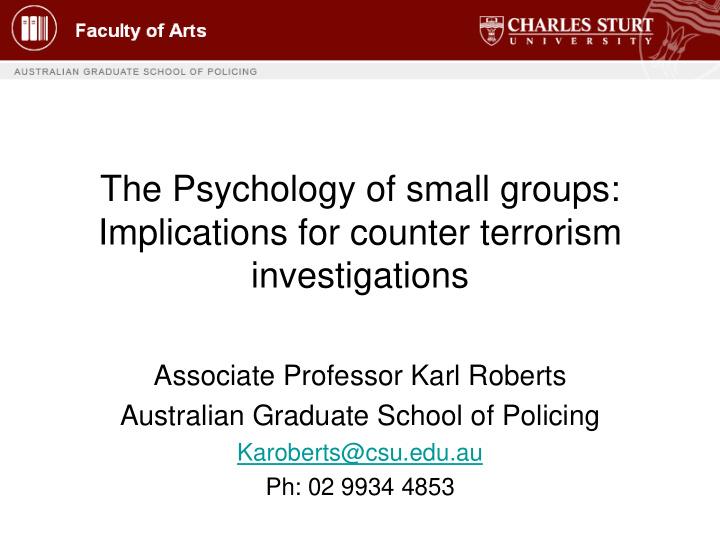



The Psychology of small groups: Implications for counter terrorism investigations Associate Professor Karl Roberts Australian Graduate School of Policing Karoberts@csu.edu.au Ph: 02 9934 4853
Aims • Psychology of small groups • Explore how small terror/criminal groups develop • Implications for counter terrorism investigations • implications for – Risk assessment – Information collection and analysis
How do groups form? • Model of group formation (Bruce Tuckman, 1965; 1977) • Four processes of formation – Forming – Storming – Norming – Performing • One stage after destruction of group – Mourning • Generally – Groups face inward at first then progressively more outward facing – Group coherence moves from low to high
Forming • When a group first comes together – Uncertainty amongst member – Shyness if strangers – Extraverts may rapidly assume leadership role • Maintaining group is major concern • Inward facing • No group identity set up • New Groups vulnerable to collapse at this stage
Storming • Inward looking, group main concern • Most uncomfortable phase • Disagreements • Jockeying for – Position – Authority – Influence • Roles eventually allocated • Initial leaders may not survive this • Group may fragment – Breakaway factions
Norming • Group inward and outward looking • What – does the group stand for? – Is expected of members? – Do members need to contribute? • Begin to form group identity • Strong group coherence makes performing most likely • May slip back to storming i.e. disagreements – E.g. AQ Azzam and Bin Laden; Breakaway factions • Again group may break up
High group coherence • Greatest when: norming successful – Group members close to each other in time and space – Meet regularly – Perceive other group members as similar to self – Prior beliefs consistent with the groups beliefs – If group is important to members – Group perceived to be different from others – Perceived threat to group – Group is separated from others – Directive leadership – Includes on-line interaction
Group think • Highest group coherence • Performance most likely
Groupthink Symptoms • A feeling of invulnerability creates excessive optimism and encourages risk taking. • Discounting warnings that might challenge assumptions. • An unquestioned belief in the group’s morality, causing members to ignore the consequences of their actions. • Stereotyped views of outsiders. • Pressure to conform against members of the group who disagree. • Shutting down of ideas that deviate from the apparent group consensus. • An illusion of unanimity with regards to going along with the group. • Mindguards — self-appointed members who shield the group from dissenting opinions
She would expand on this collaboration via continued work with Kebbell and Roberts and additional work with Ph.D. scholar Nina Performing • Outward looking • Group begins to act out • Acts may be reviewed • i.e. consider performance – did it work? – did someone fail? If so who? – who’s fault was failure? – Is the leader good enough? – Are our goals valid • Can slip back to storming or re-norming • Performing also way of creating and maintaining group coherence
Mourning • If the group breaks up • Feelings of distress • Desire to be back with the group • Attempts to recreate the group or similar – Red Army Faction - at least 3 incarnations – 21/7 bombers phone calls
Relationship forming Mourning performing storming norming
Implications for CT Investigations • Identifying group stages – Possible weak points of group – Points of intervention/disruption • Evidence for behaviours showing – group coherence – Group think • Risk – When is a group greatest and least threat? – Targeted and types of intervention • Mourning – – Behaviours after arrest – after arrest - separate members/minimize contact?
Conclusions • Application of behavioural science model to investigation • Tuckman’s model – Simplistic and applicable – Makes predictions – Allows reasoned judgements • Some success in use in UK CT
Any Questions? Associate Professor Karl Roberts Australian Graduate School of Policing Charles Sturt University Manly Sydney Australia Karoberts@csu.edu.au Ph: 02 9934 4853
Recommend
More recommend